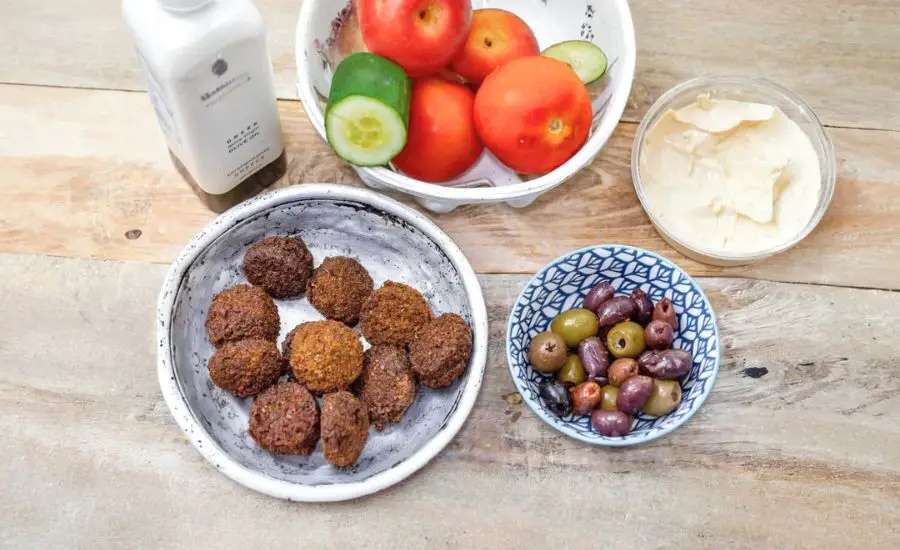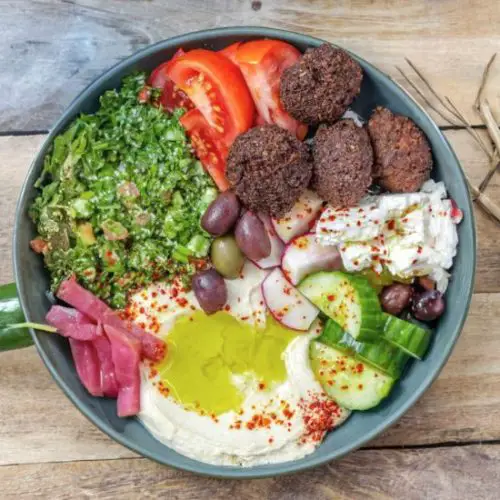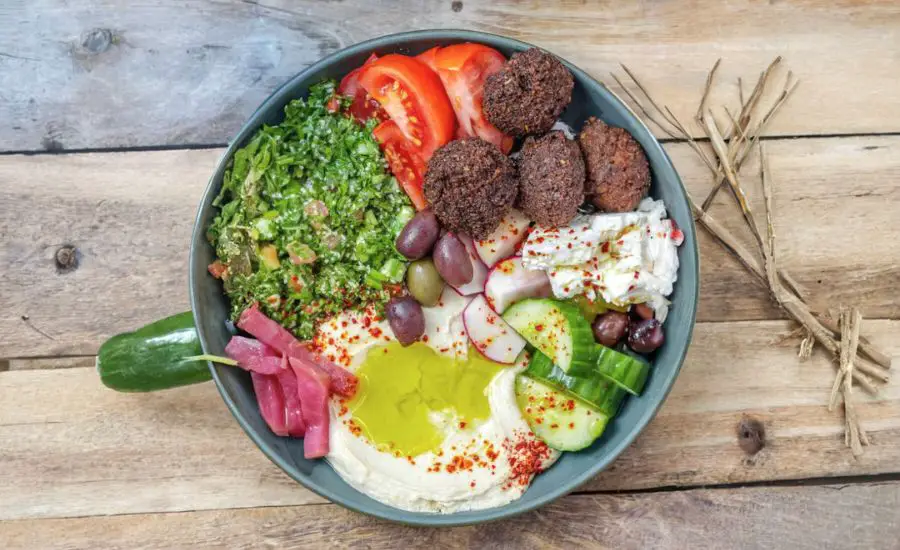All products are selected by our editorial team for quality. If you buy through our links, we may earn a small commission at no extra cost to you.
This Mediterranean Falafel Bowl is a delicious, vibrant meal that brings together wholesome ingredients bursting with flavor and nutrition.
What makes this recipe truly special is its perfect balance of plant-based protein from falafel, fiber-rich vegetables, and heart-healthy fats from extra virgin olive oil and feta cheese.
It’s naturally gluten-free, rich in antioxidants, and low in saturated fats, making it an excellent choice for those aiming for a nutrient-dense, plant-forward diet.
Beyond its health benefits, the recipe is incredibly flexible and easy to prepare, ideal for quick weeknight dinners or meal prepping for busy days.

With simple assembly and minimal cooking time—especially when using pre-made falafel—it’s both satisfying and convenient, encouraging a fresh, wholesome eating habit without sacrificing flavor.
Must-Have Tools for Perfect Results
Shallow Dinner Bowls
Essential for assembling and presenting this vibrant falafel bowl, these bowls provide ample space to arrange ingredients beautifully. Beyond this recipe, they’re perfect for serving salads, grain bowls, and pasta dishes, enhancing any meal’s presentation.
Sharp Chef’s Knife
Vital for slicing fresh vegetables like tomatoes, cucumbers, and radishes with precision and ease. A quality chef’s knife makes prep faster, safer, and more enjoyable for everyday cooking.
Mixing Bowls
Useful for tossing the tabouli salad or mixing falafel ingredients if making from scratch. Durable mixing bowls are versatile kitchen staples for baking, marinating, and prepping any dish.
Air Fryer (Optional)
If you prefer homemade falafel, an air fryer crisps patties to golden perfection without deep frying, reducing oil usage. This appliance is a healthy, time-saving tool for cooking a variety of meals with less fat.

Delicious Falafel Salad Bowl You’ll Love
Equipment
- 4 Shallow dinner bowls
- 1 Sharp chef’s knife
- 1 Set of Mixing Bowls
- 1 Air fryer (optional)
Ingredients
- 3 –4 tbsp Hummus homemade or store-bought
- 1 cup Tabouli salad
- 16 Falafel patties homemade, air-fried, or store-bought
- 2 Medium vine-ripe tomatoes halved and sliced
- 1 English cucumber halved and sliced
- 6 Radishes halved and sliced
- ½ Medium red onion thinly sliced
- 4 oz Feta cheese sliced
- Extra virgin olive oil for drizzling
- Sumac for seasoning (optional)
Instructions
- Prepare Your Serving Bowls: Begin by selecting four shallow dinner bowls. These provide enough surface area to neatly arrange all the components of your falafel bowl, allowing each ingredient to shine and making the meal visually appealing. Place the bowls on your countertop or dining table, ready for assembly.
- Spread the Creamy Hummus Base: Using a spoon or small spatula, generously spread about 3 to 4 tablespoons of hummus on one side of each bowl. This creamy layer acts as the flavorful foundation of your bowl, adding richness and moisture. Whether you use homemade or store-bought hummus, ensure it’s evenly spread to create a smooth bed for the other ingredients to sit on.
- Add the Fresh Tabouli Salad: Next, take about one cup of tabouli salad and spoon it adjacent to the hummus in each bowl. Tabouli brings a refreshing burst of lemony, herby flavor with its mix of parsley, tomatoes, and bulgur (or quinoa if preferred). Distribute the salad evenly across all bowls to maintain a balanced portion.
- Arrange the Crispy Falafel Patties: Place 3 to 4 falafel patties on top of the hummus and tabouli, slightly overlapping if necessary. If you’re using homemade falafel, ensure they are cooked until golden and crispy—whether air-fried or pan-fried—to provide a satisfying crunch. Store-bought falafel can be warmed according to package instructions. The falafel adds a hearty, plant-based protein punch essential for satiety.
- Layer the Fresh Vegetables: Fill the remaining spaces in the bowl with your fresh vegetables: sliced vine-ripe tomatoes, cucumber, radishes, and thinly sliced red onion. Aim for a colorful, vibrant arrangement that balances texture and flavor. These vegetables contribute crispness, hydration, and vital nutrients, brightening the bowl both visually and nutritionally.
- Add the Tangy Feta Cheese: Nestle slices or small chunks of feta cheese around the vegetables and falafel. The creamy, salty feta complements the earthiness of the falafel and the freshness of the salad, adding depth and a touch of indulgence. Be generous but balanced to avoid overpowering the other flavors.
- Drizzle with Extra Virgin Olive Oil: Finish each bowl by drizzling a good-quality extra virgin olive oil over the entire assembly. Use a spoon or a small pouring bottle to control the amount. The olive oil enriches the bowl with healthy monounsaturated fats and a peppery, fruity aroma that ties all elements together beautifully.
- Season with Sumac (Optional): If desired, sprinkle a pinch of sumac over the bowl as a final touch. Sumac adds a subtle, tangy citrus flavor and a beautiful deep reddish color, enhancing the overall taste and presentation. This step is optional but highly recommended for an authentic Mediterranean flavor profile.
- Serve Immediately and Enjoy: Once assembled, serve the falafel bowls immediately to enjoy the contrasting textures—crispy falafel, creamy hummus, fresh vegetables, and crumbly feta—at their best. If preparing in advance, keep components separate and assemble just before serving to maintain freshness.
Notes
- Prepare falafel patties ahead of time and refrigerate or freeze to save cooking time on busy days.
- Use fresh, high-quality extra virgin olive oil for the best flavor impact.
- Feel free to customize the vegetables to whatever you have on hand; bell peppers or carrots work well.
- Sumac is optional but adds a beautiful tangy depth—substitute with a squeeze of fresh lemon if needed.
- For a vegan version, omit the feta cheese or replace it with a plant-based alternative.
Chef’s Secrets for Flavor Perfection
To elevate your Mediterranean Falafel Bowls, start by choosing falafel that’s crisp outside yet tender inside.
Homemade falafel or air-fried patties retain better texture than store-bought frozen varieties, but quality store-bought options can work in a pinch.
When spreading hummus, aim for a thick, even layer to provide creaminess that contrasts with the crunchy falafel and fresh veggies.
For an extra flavor boost, drizzle the olive oil slowly and opt for a peppery, fruity variety—it acts as the final seasoning, bringing the entire bowl together.
Don’t overlook the sumac; its subtle citrus notes add brightness that elevates the bowl’s complexity.
Finally, balance your fresh veggies’ texture and colors for a bowl that’s as visually inviting as it is delicious.
Serving Suggestions to Impress Guests
This falafel bowl is versatile and can be served as a fulfilling lunch or dinner.
Pair it with warm pita bread or flatbread to scoop up every bite. A side of tzatziki or a tahini sauce makes an excellent creamy accompaniment that complements the Mediterranean flavors.
For entertaining, present the bowls alongside small plates of olives, pickles, or marinated artichokes to create a mezze-style spread.
The bowls also hold up well for meal prep—pack ingredients separately and assemble when ready to eat, ensuring freshness and texture remain intact.
Consider serving with a crisp white wine like Sauvignon Blanc or a refreshing sparkling water with lemon for a complete dining experience.
Storage Tips for Freshness and Flavor
If you have leftovers, store components separately for best results.
Keep falafel patties in an airtight container in the refrigerator for up to 3 days, and reheat gently in an air fryer or oven to preserve their crispiness.
Hummus and tabouli salad can be refrigerated in sealed containers for 2 to 3 days without losing flavor.
Fresh vegetables are best sliced just before serving but can be prepped a day in advance and stored covered in the fridge.
Avoid adding feta or olive oil until serving to prevent sogginess.
When freezing falafel patties, freeze uncooked patties on a baking sheet first, then transfer to a freezer bag for up to 1 month.
Thaw and cook directly from frozen for convenience.
Frequently Asked Questions About Recipe
1. Can I make falafel from scratch for this recipe?
Absolutely! Homemade falafel offers the best flavor and texture. Use soaked chickpeas, fresh herbs, and spices, then pan-fry or air-fry until golden and crisp.
2. Is this recipe suitable for a vegan diet?
Yes! Simply omit the feta cheese or substitute with a vegan cheese alternative. The falafel, hummus, and fresh veggies are naturally plant-based.
3. How can I keep the falafel crispy when storing leftovers?
Store falafel patties separately in an airtight container and reheat in an air fryer or oven. Avoid microwaving as it can make them soggy.
4. What can I substitute for sumac if I don’t have it?
Sumac adds a tangy, lemony flavor. If unavailable, a light sprinkle of lemon zest or a squeeze of fresh lemon juice works well as a substitute.
5. Can I add grains or rice to make it more filling?
Definitely! Adding cooked quinoa, couscous, or brown rice makes the bowl more substantial and boosts fiber content for a hearty meal.
This recipe is inspired by themediterraneandish and has been carefully refined to enhance clarity, streamline preparation steps, and ensure accurate results. We’ve also included health benefits, nutritional highlights, and Must-Have Tools to help you get the best results every time you cook.


